- News
- Reviews
- Bikes
- Accessories
- Accessories - misc
- Computer mounts
- Bags
- Bar ends
- Bike bags & cases
- Bottle cages
- Bottles
- Cameras
- Car racks
- Child seats
- Computers
- Glasses
- GPS units
- Helmets
- Lights - front
- Lights - rear
- Lights - sets
- Locks
- Mirrors
- Mudguards
- Racks
- Pumps & CO2 inflators
- Puncture kits
- Reflectives
- Smart watches
- Stands and racks
- Trailers
- Clothing
- Components
- Bar tape & grips
- Bottom brackets
- Brake & gear cables
- Brake & STI levers
- Brake pads & spares
- Brakes
- Cassettes & freewheels
- Chains
- Chainsets & chainrings
- Derailleurs - front
- Derailleurs - rear
- Forks
- Gear levers & shifters
- Groupsets
- Handlebars & extensions
- Headsets
- Hubs
- Inner tubes
- Pedals
- Quick releases & skewers
- Saddles
- Seatposts
- Stems
- Wheels
- Tyres
- Health, fitness and nutrition
- Tools and workshop
- Miscellaneous
- Buyers Guides
- Features
- Forum
- Recommends
- Podcast
TECH NEWS
Shimano Road Disc camp: day 2
Another day in Sicily, another chance to have a play with Shimano's new road disc system. This time it was a lumpy 50km loop north of Zafferana where we're staying: more time on the system and more varied terrain for testing, although sadly the weather remained fine and dry. We were disappointed about that, as you can imagine.
A bit more detail on the brakes first. These first-incarnation hydraulics from Shimano are Di2-only because the master cyclinder (Shimano use the same mineral oil as they do for their mountain bike brakes) sits in the space where the mechanical shiftgear used to go. Behind a shiny silver cover.
Pop that cover off and things become a bit clearer. The cylinder itself sits towards the rear of the unit, and the brake lever extends up behind the cover to pivot in a similar position to other Shimano STIs, so the feel of the lever arc is very similar. That screw on the front of the lever allows you to adjust the reach for smaller hands.
There's another screw around the side of the lever body, which lets you adjust the bite point of the brakes. Screw it right in and it's more aggressive, or let it out for a longer throw.
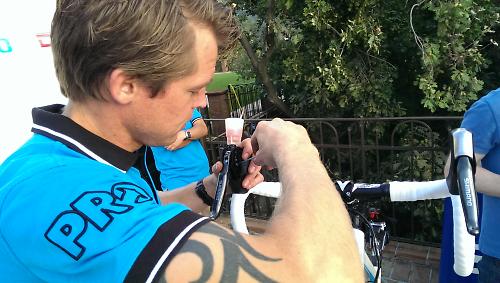
Magnus from Shimano took us through the bleed process for the discs, which anyone who's bled one of the current crop of Shimano's mountain bike discs will find very familiar. The system is bled from the bottom up, to give any air trapped in the components a greater chance of escaping. The basic procedure is to introduce mineral oil at the calliper, which is then pushed through the system and collected in a funnel that you attach to the lever. Pushing 20ml of oil through (the amount the closed system contains) is normally enough to get rid of any trapped air. You have to be careful to keep the oil off the brake blocks (for obvious reasons) so Shimano recommend removing them and putting a plastic block in their place. Everything you need for a full bleed is contained in a kit that's available from Shimano.
If you need to replace a hose, for instance to move the brakes to another frame, then the road hydraulics use the same hoses and connectors as their mountain bike counterparts.
One thing worth pointing out is that the BMC bikes that the brakes were attached to are using 160mm rotors. This isn't because Shimano recommend a 160mm, but because 140mm – which they do recommend – isn't a post mount standard at the moment and there aren't many bikes and forks available.
Shimano aren't concerned about heat build up causing the system to fail. That's one of the things they've spent a lot of time on, including pushing test pilot Tim down the Stelvio with a diver's weight belt taking his body mass up to 130kg.
For the callipers, Shimano are using Ice-tech pads which have been available on mountain bikes for some time. The pad is bonded to an alloy carrier which extends out of the brake and into a series of cooling fins to help disspiate the heat generated by braking. In fact the whole calliper is borrowed from mounatin biking, pretty much: it's basically an XT unit.
Ice-tech rotors are also used. These comprise two steel braking surfaces with an alloy layer sandwiched between. The alloy conuducts heat much faster than steel and moves the heat away from the rotor and into the alloy carrier that attaches the disc to the wheel.
That alloy layer also extends from the inner circumference of the disc into a series of cooling fins, something that Shimano call Freeza. The combination of pads and rotors means that braking temperatures are reduced by up to 150°C compared to steel discs and non-finned pads. And that means that Shimano are confident that 140mm rotors are plenty for most riding, although they do suggest that heavier riders might prefer the increased stopping power of the larger 160mm ones.
Yesterday on the first test of the brakes I found them to offer good power and modulation, but they were pretty noisy. Through the second day's ride the pads started to bed in and the amount of screeching lessened considerably; by the end of the day the front brake was pretty much silent and the rear (which I use a lot less) was starting to calm down too. Given that they've only had about 90km of riding from new, that's acceptable. I'd expect them to stop squealing after maybe 150km of dry riding, much less in filthy UK conditions which bed discs in a lot quicker.
When your disc brakes are noisy there's two processes going on simultaneously in your brain. On the first hand you want to brake as effectively as possible, and on the second you want to do things that stop the brakes from making too much noise, in your reserved British way. So although the noise doesn't greatly affect the function of the brake, it cann affect how you use them.
With the noise diminishing, using the brakes was a much more pleasant experience, and I found that the ability of the front brake to scrub off speed on the twisty descent into Linguaglossa was such that I barely used the rear. It brought me up sharp when a van decided to overtake a parked lorry and squeeze us into a two foot gap between his tyres and a wall made of lava, too. So that's good. On the more stop-start run through the coastal town of Giarre they were very well behaved; they have a sharper bite than most discs I've used on the road but it's not unpleasant, just different. And you can adjust the lever feel to a certain extent too.
It didn't rain or snow, and it wasn't muddy, so I can't really comment on the all-weather performance of the brakes, which is a shame because that'll be one of the primary reasons that people will want to buy them. But once we have a set down in the West country there'll be near-endless opportunitites to put them through their paces in filthy conditions. And I'm looking forward to doing so.
Obviously the new discs are Di2-only so we've been running them with new 11-speed Ultegra Di2: the next report will focus on that.
Dave is a founding father of road.cc, having previously worked on Cycling Plus and What Mountain Bike magazines back in the day. He also writes about e-bikes for our sister publication ebiketips. He's won three mountain bike bog snorkelling World Championships, and races at the back of the third cats.
Latest Comments
- brooksby 42 min 31 sec ago
So the choice appears to be safer, flexible wands which don't do anything to stop motorists driving over them to park, or more rigid, less safe...
- mdavidford 50 min 45 sec ago
Seems probably even more appropriate than what I originally intended.
- slc 2 hours 2 min ago
Credit to the author for attending the opposition meetings and trying to understand their concerns, but I agree with hp. There has been significant...
- RoubaixCube 3 hours 3 min ago
I like how youre using a Mojito X to advertise an Mojito 3
- Basemetal 3 hours 24 min ago
The PU dip on the palm and fingers is over the knitted nylon so not chilly in use, and the material is thick enough to provide some cushioning. It...
- Geoff H 3 hours 38 min ago
“jumped-up, arrogant” cyclists motorists causing “carnage” and posing a risk to pedestrians everyone else. Fixed it ..........
- chrisonabike 3 hours 49 min ago
Given that - at least in UK- we have a mostly flip-flop political system and parties in power eventually run out of credit with the electorate -...
- OldRidgeback 4 hours 51 min ago
If he'd been able to get hold of one of the rarer five speeds, it would've had a better choice of ratios. You can see it's got proper brakes, a big...
- David9694 5 hours 1 min ago
But whAT aboUT thE disable d? (Foreground left - pretty faded)

























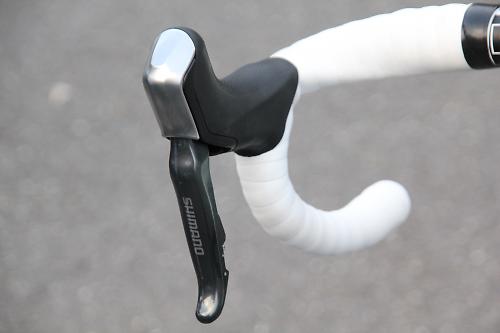
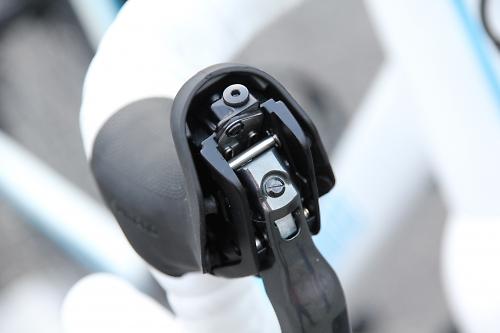
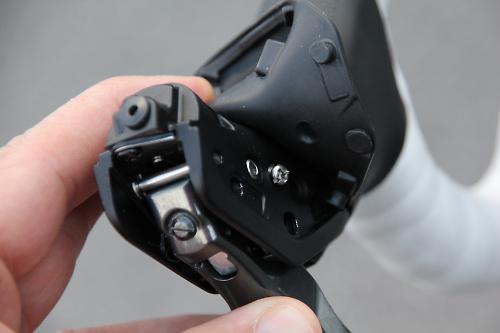
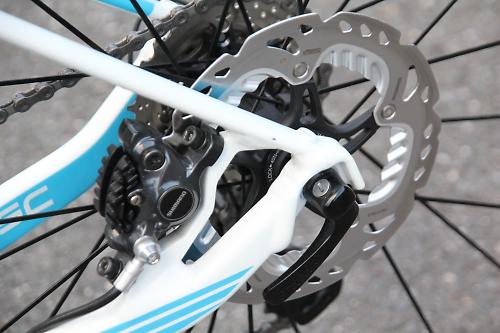
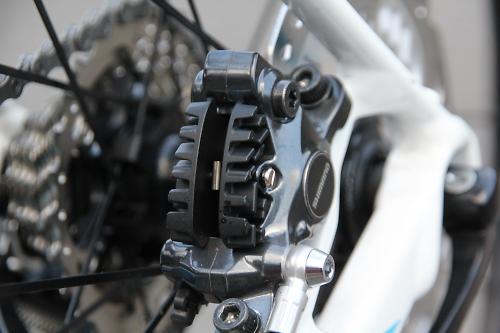

Add new comment
35 comments
.
Done any wheel changes at all?
It's easy to end up with disc rubbing IME. Wonder how that will be dialled out for race day changes in the peloton.
Yes, that would be interesting to find out. With my MTB, I had massive problems trying to align the wheel/disc to the frame after tube/tyre changes (especially with the rear). In fact, once after a tyre change it took me two days to get it right (tip: do it in daylight!)
I thought the Shimano disc set-up (and SRAM) was dual-piston ? Any adjustment on that should be able to be done with a quick tweak to the barrel adjuster, if required.
been using Shimano, Avid, Magura, Hope, Hayes, Sachs hydraulic mountain bike disc brake systems for many years, and as a professional bike mechanic worked on 100s of disc brakes
cannot said I've had issues with rubbing from doing wheel changes? If the brake caliper centre is properly centred over the rotor (not disc pads centred over rotor, a common mistake)
and piston / seals are maintained (not really an issue on Mineral Oil systems like Shimano, but definitely on discs using corrosive DOT fluid) then it should not be an issue
Pages